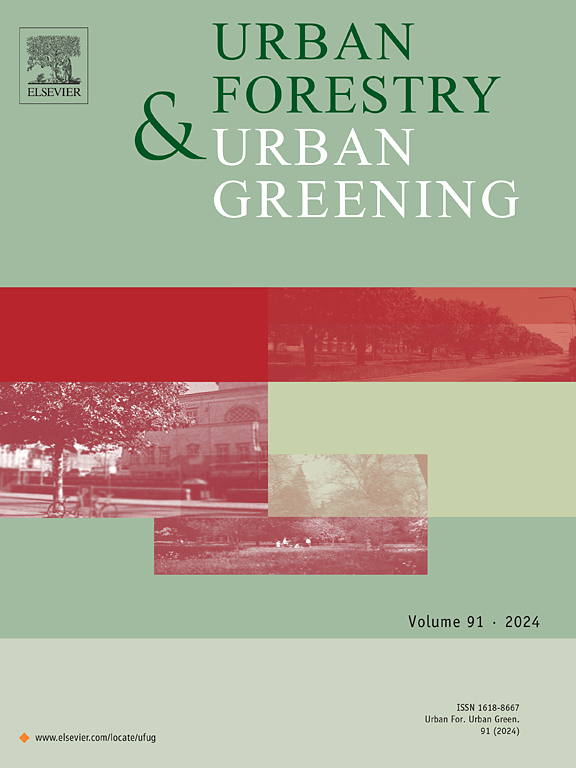评估城市绿地提供的文化生态系统服务 (CES) 的分配公正性:博洛尼亚案例
IF 6
2区 环境科学与生态学
Q1 ENVIRONMENTAL STUDIES
引用次数: 0
摘要
文化生态系统服务(CES)和相关的惠益流--对社会和个人的健康与福祉有重大影响--通常被赋予非消费价值。然而,尽管人们越来越认识到文化生态系统服务对公民生活质量的贡献,但由于其无形性,很难对其进行量化,也很难将其纳入决策和规划过程。然而,对社区环境服务的社会意义进行评估,在很大程度上有助于改善人们的福祉和生活质量。生态系统服务补偿不仅取决于城市绿地的特征和功能,还取决于与绿地互动的用户的偏好和需求,以及他们对共同创造与生态系统服务补偿相关的效益和价值的贡献。这些不同的需求,再加上城市绿地分布不均以及城市绿地管理方式的多样化,都可能影响到生态系统服务的生产方式,并进一步加剧现有的不平等和差距。本文以博洛尼亚市为案例进行研究,引入了一种基于新的、多元化的城市绿地概念的空间方法,该方法考虑了体育设施和绿色管理员的活动,以评估相关的 CES 共同生产路径和城市正义的分布维度。结果显示,整个博洛尼亚市的城市绿地可达性良好(约 0.70%)。然而,在人口脆弱性指数较高的城市地区,由于城市绿地设施和绿色管家活动较少,CES 共同生产路径受到限制,从而突出了分配和程序不公正路径较高的地区。本文章由计算机程序翻译,如有差异,请以英文原文为准。
Assessing distributional justice around Cultural Ecosystem Services (CES) provided by urban green areas: The case of Bologna
Cultural Ecosystem Services (CES) and related flows of benefits – heavily influencing societal and individual health and wellbeing - are usually ascribed non-consumptive values. However, despite the increasing recognition of their contribution to citizens’ quality of life, the intangible nature of CES makes it difficult to quantify them and hard to be integrated in decision making and planning processes. Nevertheless, the assessment of the societal relevance of CES would largely help to improve people wellbeing and quality of life. CES depend not only on the characteristics and features of urban green areas, but also on preferences and needs of the users that interact with them and that contribute to co-produce ES related benefits and values. These diverse needs, coupled with the uneven distribution of urban green area and diverse ways of managing them in the city, could affect the way ES are produced and further exacerbate existing inequalities and disparities. This contribution investigates the case study of the city of Bologna, introducing a spatial approach based on a new and pluralistic notion of urban green area that consider sport facilities and Green Stewards activities, to assess the related CES co-production paths and distributional dimension of justice in the city. Results show a good accessibility to urban green area throughout the city of Bologna (around .70 %). Nevertheless, CES co-production paths are limited in those areas of the city with higher population vulnerability index, due to lower urban green area facilities and green stewards activities, thus highlighting areas with higher distributional and procedural injustice path.
求助全文
通过发布文献求助,成功后即可免费获取论文全文。
去求助
来源期刊

Urban Forestry & Urban Greening
FORESTRY-
CiteScore
11.70
自引率
12.50%
发文量
289
审稿时长
70 days
期刊介绍:
Urban Forestry and Urban Greening is a refereed, international journal aimed at presenting high-quality research with urban and peri-urban woody and non-woody vegetation and its use, planning, design, establishment and management as its main topics. Urban Forestry and Urban Greening concentrates on all tree-dominated (as joint together in the urban forest) as well as other green resources in and around urban areas, such as woodlands, public and private urban parks and gardens, urban nature areas, street tree and square plantations, botanical gardens and cemeteries.
The journal welcomes basic and applied research papers, as well as review papers and short communications. Contributions should focus on one or more of the following aspects:
-Form and functions of urban forests and other vegetation, including aspects of urban ecology.
-Policy-making, planning and design related to urban forests and other vegetation.
-Selection and establishment of tree resources and other vegetation for urban environments.
-Management of urban forests and other vegetation.
Original contributions of a high academic standard are invited from a wide range of disciplines and fields, including forestry, biology, horticulture, arboriculture, landscape ecology, pathology, soil science, hydrology, landscape architecture, landscape planning, urban planning and design, economics, sociology, environmental psychology, public health, and education.
 求助内容:
求助内容: 应助结果提醒方式:
应助结果提醒方式:


